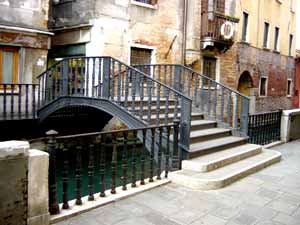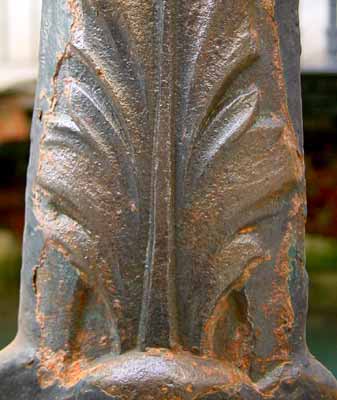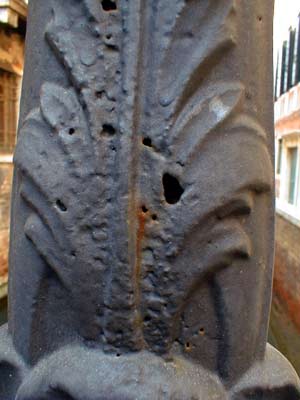
Looting of Venice: the Dona Onesta bridge
Powered by |
Saccheggio di Venezia, il ponte de la Dona Onesta Looting of Venice: the Dona Onesta bridge |
| back |
| Localizza il ponte sulla mappa dettagliata |  |
Locate this bridge on the detailed map |
| Il ponte della Donna Onesta era un grazioso ponticello in ghisa vicino alla crosera San Pantalon (vedi sulla mappa). È stato smontato e portato via con il pretesto di un restauro. Al suo posto è stato ricollocato un manufatto falso e realizzato grossolanamente. In spregio alla pubblica intelligenza, sul posto sono state lasciate le colonnine che, di identica fattura, completavano il ponte chiudendo le rive dal lato della fondamenta. Dal raffronto con queste, possiamo molto ben vedere i difetti del falso che è stato loro affiancato. In più di un incontro pubblico, i "restauratori" hanno ripetutamente affermato che il ponte è stato solo rinforzato e che le colonnine sono ancora quelle originali, dopo una sabbiatura e una riverniciatura. Ma le colonne del ponte "restaurato" rivelano oltre ogni ragionevole dubbio di essere brutte copie. Vediamo perché. Si notano sulla colonna nuova (foto a destra) profondi difetti di fusione che ne deturpano la superficie: sono le cosiddette "soffiature", dovute a bolle di gas che si sono sviluppate nello stampo al momento del getto di metallo fuso. Sulle colonne vecchie (foto a sinistra), realizzate a suo tempo da ben altri artigiani non si rileva alcuna soffiatura, né si notano noduli di grafite (che avrebbero potuto venir asportati da un comunque errato procedimento di sabbiatura) di dimensioni e frequenza paragonabili alle cavità presenti sulle colonne nuove. Mi sono preso la briga di rimuovere le croste di vecchia vernice da una di queste per accertarmene, anche se si vede benissimo anche con la pittura che la qualità del getto e del metallo vecchio niente ha a che spartire con quello nuovo. Proprio le croste di vecchia vernice hanno con ogni probabilità causato le soffiature: i "restauratori", infatti, per ottenere le copie, hanno premuto gli originali così come stavano nella terra da fusione, e molte crosticine di pittura si sono staccate aderendo allo stampo. Quando nello stampo si è poi gettato il metallo alla temperatura di oltre 1100 gradi, i frammenti di pittura si sono trasformati in bolle di gas, provocando le brutture che si vedono nella foto e che si possono con comodo verificare in tutto il nuovo e falso manufatto del ponte. Un altro aspetto del "restauro" che merita di essere evidenziato è l'assoluta inosservanza delle elementari norme di finitura a vernice del manufatto. Elaborate negli Stati Uniti dove le architetture in ghisa sono considerate beni storici, in quanto nei secoli scorsi questa lega ebbe largo impiego addirittura nella costruzione di interi edifici, queste norme suggeriscono che si operi un'analisi della verniciatura originale e la si riproduca fedelmente (cfr. The Maintenance and Repair of Architectural Cast Iron ); nel nostro caso le "ghise" nuove vengono coperte da una assai poco resistente patina che dell'originale non ha nemmeno il colore... I cosiddetti "restauratori", curiosamente, hanno del tutto dimenticato di allegare foto dello stato di fatto precedente al restauro, nelle loro ricche quanto spudoratamente menzognere pubblicazioni. |
This is a lovely little cast iron bridge located near San Pantalon (see on the map). It was dismounted and taken away under pretext of restoration. It was replaced with a poorly made fake. As an offence to public intelligence, the small columns on the ends of the bridge along the shore were left in place. In comparison, you can easily note the defects of the fakes and the originals that remain at their side. As well, during a public meeting, the "restorers" repeatedly affirmed that the bridge was only reinforced and that the columns are the originals, only sanded and re-varnished. But the columns of the restored bridge reveal without doubt to be ugly copies. Let's see why. It is noted (see right photo) on the new column profound defects of the casting that damaged the surface, a bubbling effect (flaws) which is caused by gas developing in the mould at the moment of casting the fused metal. On the old columns (left photo), made at the time by true artisans, you do not notice the "bubbling", nor do you see any graphite nodules (which could have been taken away by an incorrect procedure of sand blasting) of the dimension and frequency in comparison to the hollows present in the new columns. I took the trouble to remove a piece of the old varnish from one of the originals for verification, even if you can easily see by the painting that the quality of casting of the old metal has nothing in common with the new. The crust of the old varnish probably caused the "bubbling". "Restorers," in fact, to obtain the copies, pressed the originals as they were into the sand moulds and many fragments of paint stuck to the moulds. When in the mould and then during casting at a temperature of more than 2000 Fahrenheit degrees, the fragments of paint were transformed into gas bubbles, making it ugly as can be seen in the photo. As well, it is easy to verify in all of the new fake bridges. Another aspect of the "restoration" that merits to be in evidence is the absolute inobservance of the elementary rules of varnishing. Elaborated in the United States where cast iron architecture is considered historic, in how much that in centuries past this alloy was greatly applied directly to the construction of whole buildings, this rule suggests the use of an analysis of original varnishing to make an exact reproduction, both for aesthetical and roast-prevention reasons (see "The Maintenance and Repair of Architectural Cast Iron"); in our case the new "cast iron" comes covered by a not very resistant gloss that does not even have the original color… The so-called "restorers", curiously, have forgotten to attach a photo from before restoration in their shameless and fake publications. |
| Colonnina originale, particolare del fregio Original small column, detail of decoration  |
Falso attualmente in opera Forgery actually on site  |
foto e testo di Umberto Sartory
back